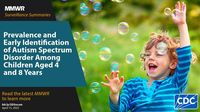Autism diagnoses among children in the United States continue to rise, with a new report from the Centers for Disease Control and Prevention (CDC) revealing that approximately one in 31 children aged 8 years were diagnosed with autism spectrum disorder (ASD) in 2022. This figure represents an increase from the one in 36 diagnosed in 2020 and a significant rise from one in 150 in 2000. The report, published on April 15, 2025, highlights the growing prevalence of ASD and the factors contributing to this trend.
The CDC's findings indicate that ASD is 3.4 times more common among boys than girls, with diagnoses reported at 49.2 per 1,000 for boys compared to 14.3 per 1,000 for girls. Despite the alarming statistics, fewer than 40% of children diagnosed with ASD were classified as having an intellectual disability, suggesting a spectrum of severity in the disorder.
Racial and ethnic disparities are also evident in the report. White children had a lower prevalence of ASD at 27.7 per 1,000 compared to other groups: 38.2 for Asian or Pacific Islander children, 37.5 for American Indian/Alaska Native children, 36.6 for Black or African American children, 33.0 for Hispanic children, and 31.9 for multiracial children. These disparities point to a broader recognition and understanding of ASD across different communities.
Dr. Karyl Rattay, director of the CDC’s Division of Human Development and Disability, noted that the data collection involved 16 research institutions across 14 states and Puerto Rico. However, she cautioned that the findings may not be nationally representative, as prevalence varied widely across the sites, ranging from one in 103 in Laredo, Texas, to one in 19 in California. “This could reflect differences in availability of services for early detection, evaluation, and diagnostic practices in each community,” Rattay explained.
In light of these findings, advocacy group Autism Speaks expressed that the increasing rates of ASD reflect progress in awareness, diagnostic criteria, and screening tools. They emphasized the need for continued support and investment in the autism community to ensure that children are identified and supported effectively.
Health and Human Services Secretary Robert F. Kennedy Jr. addressed the rising rates during a recent cabinet meeting, stating that his agency would determine the causes of the autism epidemic by September 2025. Kennedy’s comments, however, sparked controversy, as some experts criticized his rhetoric. “This is an epidemic like nothing we’ve ever seen before. It dwarfs the COVID epidemic,” Kennedy claimed during an interview, a statement that has been met with backlash from autism advocates who argue that equating autism with a health crisis is misleading and stigmatizing.
Experts in the field, such as Eric Fombonne, an emeritus professor of psychiatry, assert that the increase in autism diagnoses is not indicative of a growing crisis but rather a result of improved diagnostic practices and increased access to care. “That interesting switch reflects the wide availability of autism services available to ethnic minority families — that’s a good sign,” he stated. Fombonne and others emphasize that the scientific consensus firmly debunks any link between vaccines and autism, a narrative that has persisted in some circles.
The report also highlighted the importance of early identification of ASD. Among children born in 2018, the cumulative incidence of diagnosis or eligibility by age 48 months was 1.7 times higher than among those born in 2014. This suggests that more recent cohorts are being diagnosed at earlier ages, which is crucial for accessing necessary interventions and support services.
Despite the overall increase in diagnoses, the report noted that the median age of the earliest known ASD diagnosis was 47 months, with significant variation across different states. For instance, children in California were diagnosed as early as 36 months, while those in Laredo, Texas, had a median age of 69.5 months. This disparity underscores the need for improved access to diagnostic services across various regions.
Overall, the findings from the CDC report indicate a complex landscape of autism diagnosis in the United States. While the increasing prevalence may raise concerns, it is also a reflection of better awareness, broader diagnostic criteria, and improved access to screening and services. The challenge moving forward will be to ensure that all children, regardless of their background or where they live, receive timely and effective support for ASD.
As the conversation around autism continues to evolve, it is essential to approach the topic with sensitivity and accuracy. The experiences of individuals with autism should be acknowledged and respected, rather than framed within the context of a crisis. Moving forward, the focus should remain on enhancing services, support systems, and understanding of autism to foster an inclusive society for all.






